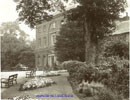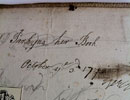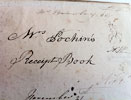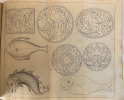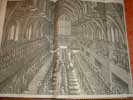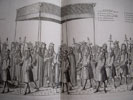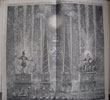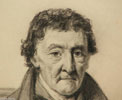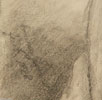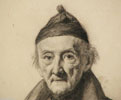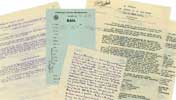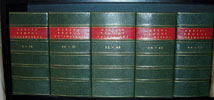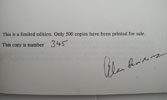The Wine and Food Society.
A GASTRONOMICAL QUARTERLY EDITED BY ANDRE L. SIMON Published for the Wine and Food Society by SIMPKIN MARSHALL, LTD. STATIONERS' HALL COURT LONDON, E.C.4. (1934).
17 Volumes. In each volume there are 4 quarterlies bound together and they all have individual title pages. All volumes bound at various times in half black calf with black cloth boards and gilt lines. The spines of volumes dated 1940 & 42 are slightly sunned. All spines with raised bands, gilt lines and tooling, with gilt lettering in three compartments. Overall all volumes internally and externally in good condition with a slight variance in standing size and thickness due to being bound at different times. ITEM #2: 222 x 152mm. 2p. Dated 15.11.56. A fine two page letter written and signed by Simon. In a nice agreeable cursive script in blue ink from his home address; to Mrs Prideaux, thanking her for the menu of the Pavilion Banquet, also explaining the meaning of 'Cafe double'. A very handsome set and rare with Simon's letter enclosed within the first volume of 1934.
- André Louis Simon (Image #1 below) born 1877 - 1970, was the charismatic leader of the English wine trade for most of the first half of the 20th century, and the grand old man of literate connoisseurship for a further 20 years. In 66 years of authorship, he wrote 104 books. For 33 years he was one of London's leading champagne shippers; for another 33 years active president of the ‘Wine & Food Society’. Although he lived in England from the age of 25, he always remained a French citizen. He was both Officier de la Légion d'Honneur and holder of the Order of the British Empire. A. L. S. was born in St-Germain-des-Prés, the second of five sons of a landscape painter who died of sunstroke in Egypt, while they were still youths. From the first his ambition was to be a journalist. At 17 he was sent to Southampton to learn English and met Edith Symons, whose ambition was to live in France. They married in 1902 and remained happily together for 63 years. A.L.S. was a man of good judgement, single-mindedness, and devotion. He was also a man of powerful charm. He became a champagne shipper, the London agent for the leading house of Pommery through his father's friendship with the Polignac family. It allowed him a base at 24 Mark Lane for 30 years, in the centre of the City's wine trade. From it he not only sold champagne; he soon made his voice heard as journalist, scholar, and teacher. Within four years of his installation in London he was writing his first book, ‘The History of the Champagne Trade in England’, in installments for the Wine Trade Review. He spoke English as he wrote it, with a fondness for imagery, even for little parables but with an ineradicable French accent that was as much part of his persona as his burly frame and curly hair. His first book of 'History' was rapidly followed by a remarkable sequel: ‘The History of the Wine Trade in England from Roman Times to the End of the 17th Century’, in three volumes dated 1906, 7 and 9. It was the best and most original of his total of over 100 books. None, let alone a young man working in a language not his own, had read, thought, and written so deeply on the subject before. It singled him out at once as a natural spokesman for wine, a role he pursued with typical energy, combining with friends to found, in 1908, the Wine Trade Club. There-after for six years he organized tastings and gave technical lectures of a kind not seen before; the forerunner by 45 years of the Institute of masters of wine. In 1919 he published ‘Bibliotheca Vinaria’, a catalogue of the books he had collected for the Club. It ran to 340 pages. Also in 1919, Simon bought the two homes he was to occupy for the rest of his life: 6 Evelyn Mansions, near Westminster Cathedral (where he attended mass daily), and Little Hedgecourt, a cottage with 28 acres beside a lake at Felbridge, Surrey. He also ended his association with Pommery after 33 years.. Simon began a second life at 55, with A. J. A. Symons he founded the Wine & Food Society (now International Wine & Food Society). Its first Alsace lunch at the Cafe Royal in London in the midst of the Depression caused a sensation. But its assured success came from the ending of prohibition in America. Sponsored by the French government, Simon traveled repeatedly to the US, founding its first Wine & Food Society branch in Boston in December 1934 and its second in San Francisco in January 1935. Starting in the spring of 1934 with the first Wine and Food Quarterly. A.L.S. immersed himself in the research, writing, and editing (and finding paper to print) the Society's Quarterlies that was to occupy him throughout the Second World War. In 1962, his friend Harry Yoxall suggested that at 85, daily responsibility for the Society and its magazine was too burdensome and bought the title from him for Condé Nast Publications. But in his 90s, Simon was still exceptional company at dinner and gave little picnics for friends beside his woodland lake. He passed away in 1970. On what would have been his 100th birthday, on 28th February, 1977, 400 guests at the Savoy Hotel in London, drank an exceptional claret to his memory, that he had with kind foresight left for the occasion; Chateau Latour 1945. (Hugh Johnson -- The Oxford Companion to Wine. 3rd edition.) These Wine and Food Society volumes provide a fascinating insight into the Catering industry and it's leading characters, for a tempestuous and epoch changing 16 years that included WW11 and after.

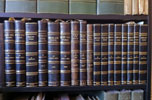




click on image to enlarge

Modern category
ref number:
11156 